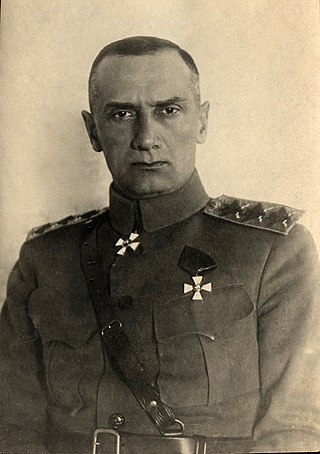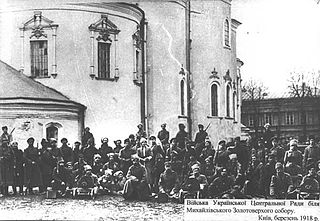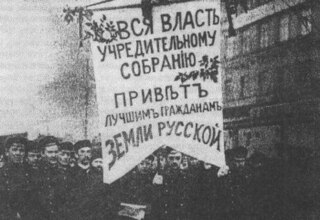| |||||
| Decades: | |||||
|---|---|---|---|---|---|
| See also: | |||||
Events from the year 1919 in Russia
| |||||
| Decades: | |||||
|---|---|---|---|---|---|
| See also: | |||||
Events from the year 1919 in Russia
| | This section needs expansion. You can help by adding to it. (July 2016) |

The Russian Civil War was a multi-party civil war in the former Russian Empire sparked by the overthrowing of the social-democratic Russian Provisional Government in the October Revolution, as many factions vied to determine Russia's political future. It resulted in the formation of the Russian Socialist Federative Soviet Republic and later the Union of Soviet Socialist Republics in most of its territory. Its finale marked the end of the Russian Revolution, which was one of the key events of the 20th century.
1918 (MCMXVIII) was a common year starting on Tuesday of the Gregorian calendar and a common year starting on Monday of the Julian calendar, the 1918th year of the Common Era (CE) and Anno Domini (AD) designations, the 918th year of the 2nd millennium, the 18th year of the 20th century, and the 9th year of the 1910s decade. As of the start of 1918, the Gregorian calendar was 13 days ahead of the Julian calendar, which remained in localized use until 1923.
1917 (MCMXVII) was a common year starting on Monday of the Gregorian calendar and a common year starting on Sunday of the Julian calendar, the 1917th year of the Common Era (CE) and Anno Domini (AD) designations, the 917th year of the 2nd millennium, the 17th year of the 20th century, and the 8th year of the 1910s decade. As of the start of 1917, the Gregorian calendar was 13 days ahead of the Julian calendar, which remained in localized use until 1923.
1919 (MCMXIX) was a common year starting on Wednesday of the Gregorian calendar and a common year starting on Tuesday of the Julian calendar, the 1919th year of the Common Era (CE) and Anno Domini (AD) designations, the 919th year of the 2nd millennium, the 19th year of the 20th century, and the 10th and last year of the 1910s decade. As of the start of 1919, the Gregorian calendar was 13 days ahead of the Julian calendar, which remained in localized use until 1923.
1920 (MCMXX) was a leap year starting on Thursday of the Gregorian calendar and a leap year starting on Wednesday of the Julian calendar, the 1920th year of the Common Era (CE) and Anno Domini (AD) designations, the 920th year of the 2nd millennium, the 20th year of the 20th century, and the 1st year of the 1920s decade. As of the start of 1920, the Gregorian calendar was 13 days ahead of the Julian calendar, which remained in localized use until 1923.
1885 (MDCCCLXXXV) was a common year starting on Thursday of the Gregorian calendar and a common year starting on Tuesday of the Julian calendar, the 1885th year of the Common Era (CE) and Anno Domini (AD) designations, the 885th year of the 2nd millennium, the 85th year of the 19th century, and the 6th year of the 1880s decade. As of the start of 1885, the Gregorian calendar was 12 days ahead of the Julian calendar, which remained in localized use until 1923.
1852 (MDCCCLII) was a leap year starting on Thursday of the Gregorian calendar and a leap year starting on Tuesday of the Julian calendar, the 1852nd year of the Common Era (CE) and Anno Domini (AD) designations, the 852nd year of the 2nd millennium, the 52nd year of the 19th century, and the 3rd year of the 1850s decade. As of the start of 1852, the Gregorian calendar was 12 days ahead of the Julian calendar, which remained in localized use until 1923.

The White movement, also known as the Whites, was a loose confederation of anti-communist forces that fought the communist Bolsheviks, also known as the Reds, in the Russian Civil War (1917–1923) and that to a lesser extent continued operating as militarized associations of rebels both outside and within Russian borders in Siberia until roughly World War II (1939–1945). The movement's military arm was the White Army, also known as the White Guard or White Guardsmen.

The Estonian War of Independence, also known as the Estonian Liberation War, was a defensive campaign of the Estonian Army and its allies, most notably the United Kingdom, against the Bolshevik westward offensive of 1918–1919 and the 1919 aggression of the Baltische Landeswehr. The campaign was the struggle of the newly established democratic nation of Estonia for independence in the aftermath of World War I. It resulted in a victory for Estonia and was concluded in the 1920 Treaty of Tartu.

The Soviet Navy was the naval warfare uniform service branch of the Soviet Armed Forces. Often referred to as the Red Fleet, the Soviet Navy made up a large part of the Soviet Union's strategic planning in the event of a conflict with the opposing superpower, the United States, during the Cold War (1945–1991). The Soviet Navy played a large role during the Cold War, either confronting the North Atlantic Treaty Organization in western Europe or power projection to maintain its sphere of influence in eastern Europe.

The Allied intervention in the Russian Civil War consisted of a series of multi-national military expeditions that began in 1918. The initial impetus behind the interventions was to secure munitions and supply depots from falling into the German Empire's hands, particularly after the Bolsheviks signed the Treaty of Brest-Litovsk, and to rescue the Allied forces that had become trapped within Russia after the 1917 October Revolution. After the Armistice of 11 November 1918, the Allied plan changed to helping the White forces in the Russian Civil War. After the Whites collapsed, the Allies withdrew their forces from Russia by 1925.

The British campaign in the Baltic 1918–1919 was a part of the Allied intervention in the Russian Civil War. The codename of the Royal Navy campaign was Operation Red Trek. The intervention played a key role in enabling the establishment of the independent states of Estonia and Latvia. It failed to secure the control of Petrograd by White Russian forces, which was one of the main goals of the campaign.

The Ukrainian War of Independence, also referred to as the Ukrainian–Soviet War in Ukraine, lasted from March 1917 to November 1921. It saw the establishment and development of an independent Ukrainian republic, most of which was absorbed into the Soviet Union as the Ukrainian Soviet Socialist Republic of 1922–1991.
The following lists events that happened during 1934 in the Union of Soviet Socialist Republics.

Alexander Vasilyevich Kolchak was a Russian admiral, military leader and polar explorer who served as Supreme Ruler of Russia from 1918 to 1920 during the Russian Civil War. Previously, he served in the Imperial Russian Navy and fought in the Russo-Japanese War and World War I.

The Ukrainian People's Republic (UPR) was a short-lived state in Eastern Europe. Prior to its proclamation, the Central Council of Ukraine was elected in March 1917 as a result of the February Revolution, and in June, it declared Ukrainian autonomy within Russia. Its autonomy was later recognized by the Russian Provisional Government. Following the October Revolution, the Central Council of Ukraine denounced the Bolshevik seizure of power and proclaimed the Ukrainian People's Republic with a territory including the area of approximately eight Russian imperial governorates. It formally declared its independence from Russia on 22 January 1918.

The Ukrainian–Soviet War is the term commonly used in post-Soviet Ukraine for the events taking place between 1917–21, nowadays regarded essentially as a war between the Ukrainian People's Republic and the Bolsheviks. The war ensued soon after the October Revolution when Lenin dispatched Antonov's expeditionary group to Ukraine and Southern Russia.
Events from the year 1917 in Russia.

Events from the year 1918 in Russia
The Orenburg Independent Army was an anti-Bolshevik Army on the Eastern Front during the Russian Civil War.
![]() Media related to 1919 in Russia at Wikimedia Commons
Media related to 1919 in Russia at Wikimedia Commons